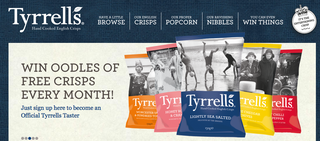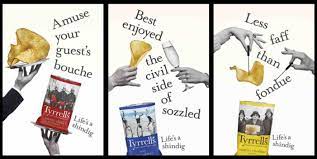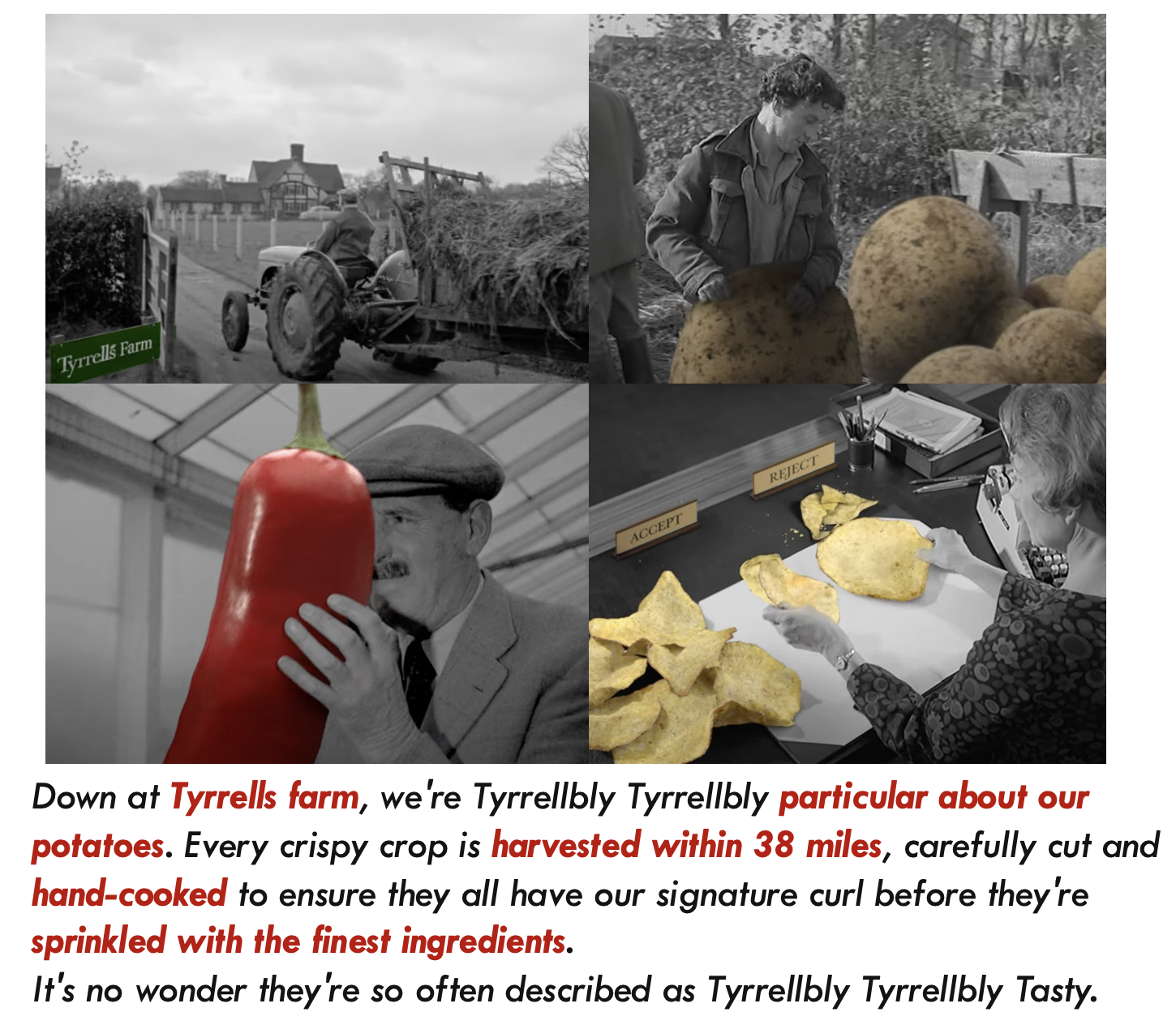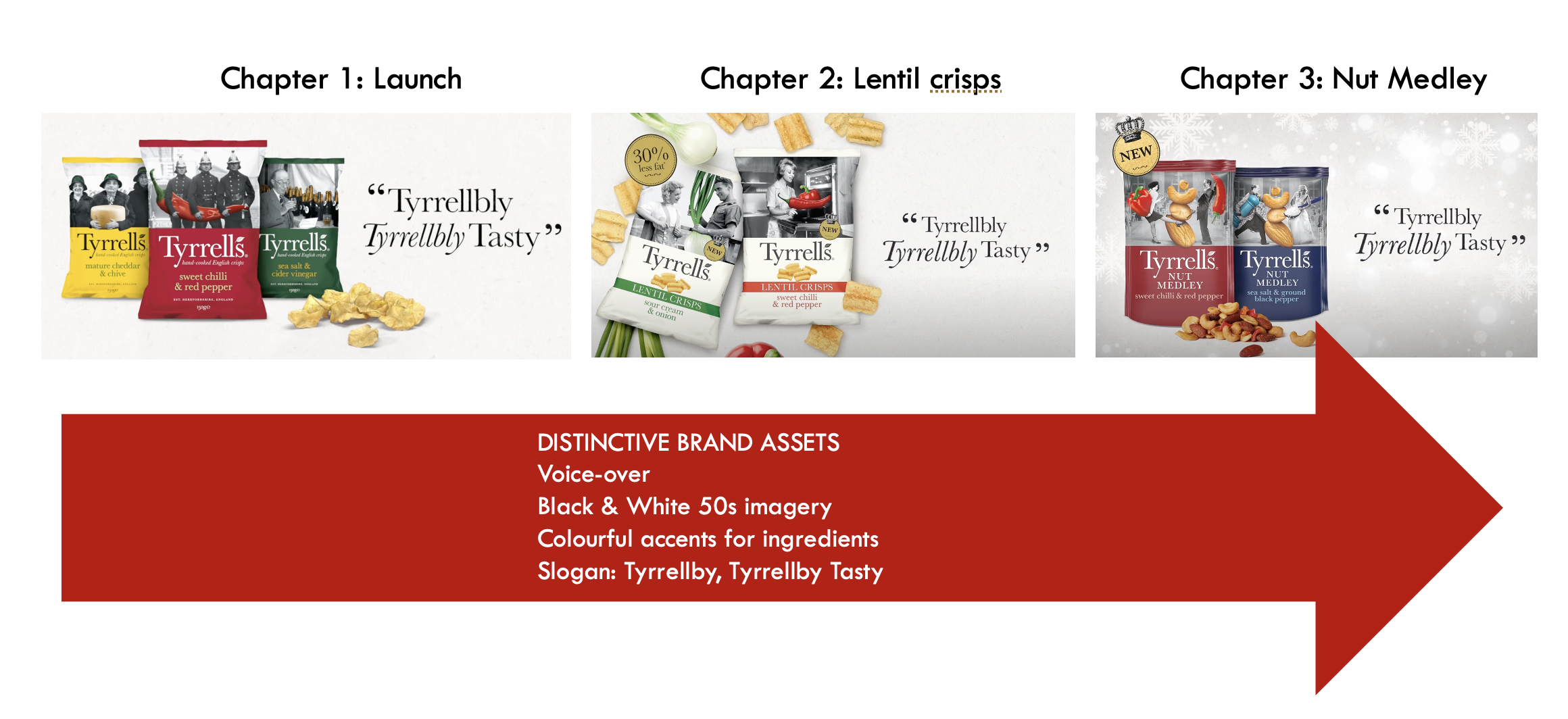Tyrells Tackle the tyranny of price promotion
This week, I came across the fascinating story of how The Tyrells brand of upmarket crisps* tackled the tyranny of price promotion. The brand owner, KP Snacks, bravely restored the brand’s price premium, supported by investment in driving distinctiveness, as revealed in the On Strategy Showcase podcast. The episode featured a fascinating interview with Dan Hulse, CSO & Partner of St. Luke’s London, the brand’s creative agency (1).
* potato chips for our US readers
The re-launch has produced good results to date. Consideration is up, particularly among the core target of 45 to 65 year olds. Sales grew +40% in the year to December 2021 versus the year to September 2019, from £33m to £47m (2). Share of the premium sharing crisps is also up, to 15.3% from 12.6%, with the brand overtaking Kettle, the previous leader in the premium, hand-cooked crisps category.
1. Premiumise with confidence
When KP Snacks acquired Tyrrells in 2018, the crisp brand was losing money. Price discounting in the category, including Tyrells, meant that the price per pack had dropped below £1. “What happened was an absolute race to the bottom,” Tyrrells global marketing controller Dan Winslet told Marketing Week (2). “That’s why the business was not making any money whatsoever.”
The strategy of ever lower prices was clearly not working for Tyrells. KP Snacks knew it had to get off “the short term drug of promotions”. I posted here about just this problem of price discounting, that I called “the crack cocaine” of marketing.
The company decided to change approach and premiumise the brand again, with the objective of being able to invest in the brand as a result. In 2019 the team took the bold decision to increase the price of Tyrrells by c.30%. In the short term there was a volume drop of about the same percentage, before sales subsequently recovered.
2. Define a core target for broad reach
The brand set about defining a core target consumer who would be willing to pay a premium price for Tyrrell’s. “The brand had the goal of “delighting someone but appealing to everyone” through its brand,” according to the Marketing Week article. “The “someone” identified was adults over 45 in the UK.”
This part of the story is interesting for a couple of reasons. First, notice how the brand didn’t follow the crowd and chase after younger Millenial or Gen Z consumers. Rather, they targeted older consumers who have a lot of buying power, plus the time and money to entertain at home, occasions when big bags of premium crisps are often consumed. Second, this is a good example of how a clearly defined core target can create a brand with broad appeal, a topic I posted on here.
3. Build on brand truths
The brand had a strong functional benefit to build on, with a product that consistently outperformed competitors in taste tests. This benefit was supported by a series of product truths. Tyrrells was still produced on a Herefordshire farm, using locally sourced potatoes and hand cooking. The challenge was how to communicate these product truths in an impactful and emotionally compelling way.“We were looking to create a brand that matched the quality of products that we had,” as Dan W. said (2).
4. Amplify distinctive brand assets
Tyrrells began working with creative agency St Luke’s London in 2019 on a brief to boost distinctiveness. A key issue to solve was that consumers confused Tyrrells with the leading brand of premium, hand-cut crisp, Kettle.
What I love about the communication created by St Luke’s is how they chose to amplify distinctive brand assets the Tyrells brand already had, rather than re-invent the wheel. Specifically, the agency looked to the brand’s distinctive pack designs for inspiration. I posted on this packaging (see below) way back in 2011 (better late than never for an agency to amplify these brand assets!):
In addition to helping create stand-out on shelf the design works as a form of extra communication, adding emotional “sizzle” – we call this “packvertising”. Each distinctive pack uses amusing, old-style black and white photography.

The designs were tweaked in 2015 to use colour to emphasise flavours (3). For example, in the mature cheddar and chive pack, the wheel of cheese held by three ladies was coloured yellow and enlarged, with the hat ribbons coloured green. The sweet chilli and red pepper flavour featured three firemen carrying a giant red chilli. These packs cue flavour in a distinctive way that taps into ‘system 1’, intuitive thinking.
St Luke’s brilliantly brought to life the static 2-d images from the pack in film form, adding a 1950s style announcer in the voice over. They also cleverly baked the brand into the campaign slogan, ‘Tyrrellbly Tasty’, to distinctively communicate the core market benefit of taste. This is a great example of a brand winning through distinctiveness, not differentiation.
5. Add emotional sizzle
A little digging uncovered the brand’s previous ad campaign from 2015, created by agency Wieden & Kennedy (4). This campaign looks to my eyes like an example of “laddering” too high in search of emotional appeal. The campaign idea of ‘Life’s a shindig’ works at a high level, focused on an attitude to life (see below). However, it misses any direct link back to the brand. Specific executions feature taglines more linked to the catgeory, such as ‘Amuse your guest’s bouche’. However, even here there is a lack of brand distinctiveness.

In contrast, the new campaign beautifully blends product “sausage” and emotional “sizzle”. The brand film tells a product story bulding on the brand truths discussed above: produced on the Tyrells Farm, using locally sourced and hand cooked potatoes (5). It does this with a humour through the black and white visuals with over-sized colourful vegetables and a tongue-in-cheek 1950s newsreader voice over (see below).

6. Create a chapter plan
The Tyrells relaunch is a lovely example of how distinctive brand assets can be harnessed to create “fresh consistency”. To do this, the brand has built what we at the brandgym call a “chapter plan”. In this approach, each campaign brings freshness and new news. For example, chapters included the launch of lentil chips and nuts. The distinctive brand assets create consistency, building and then reinforcing memory structure.

7. Engage the whole business
One of Dan Winslet’s key learnings from the re-launch process is the need to engage and align everyone in the business, from sales to finance (2). There was a need to explain the long-term nature of brand building and that this would be“a rough old journey”. For example, Dan described the initial volume drop following the price increase as “a real squeaky bum moment.” The brand team had to bring the whole business along to keep them on track.
In conclusion, Tyrells is a great example of a brand that has tackled the tyranny of price promotion by driving distinctiveness. As Dan Winslet rightly said, “People are prepared a little bit more for a brand that has a brilliant product and a brilliant equity.”
SOURCES


